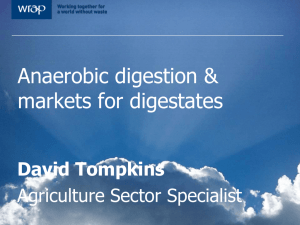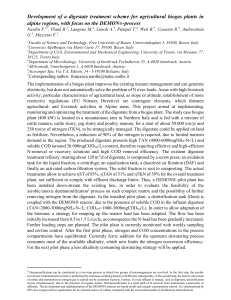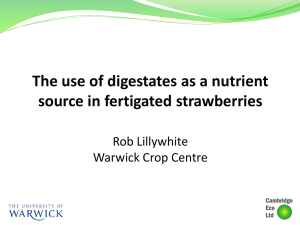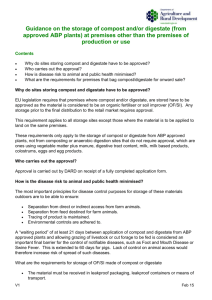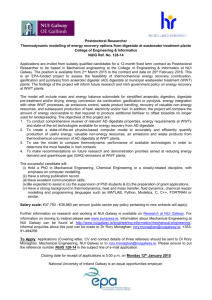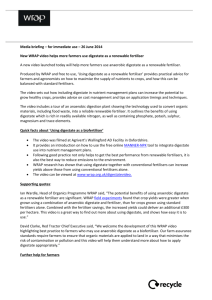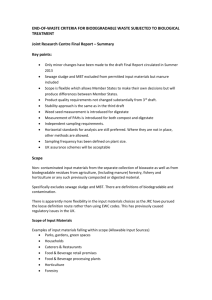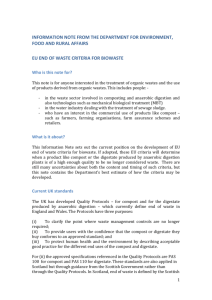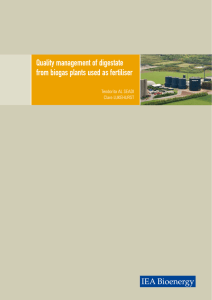REFOR14 ABC Workgroup Meeting Notes 4/ 9/14[DRAFT
advertisement
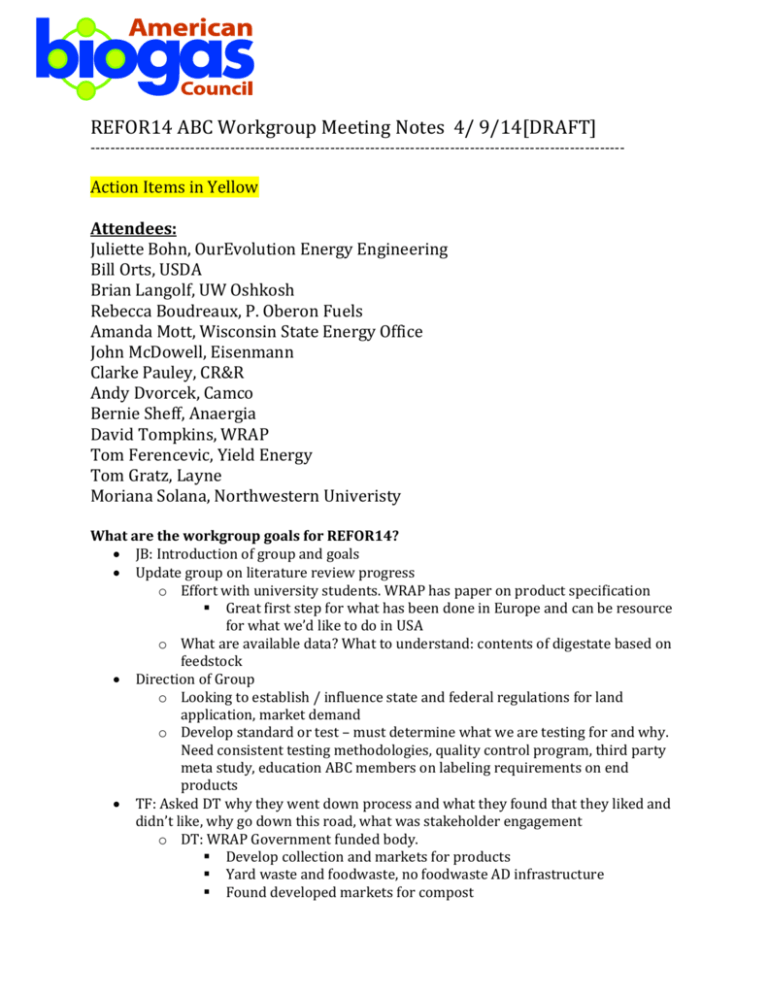
REFOR14 ABC Workgroup Meeting Notes 4/ 9/14[DRAFT] ----------------------------------------------------------------------------------------------------------- Action Items in Yellow Attendees: Juliette Bohn, OurEvolution Energy Engineering Bill Orts, USDA Brian Langolf, UW Oshkosh Rebecca Boudreaux, P. Oberon Fuels Amanda Mott, Wisconsin State Energy Office John McDowell, Eisenmann Clarke Pauley, CR&R Andy Dvorcek, Camco Bernie Sheff, Anaergia David Tompkins, WRAP Tom Ferencevic, Yield Energy Tom Gratz, Layne Moriana Solana, Northwestern Univeristy What are the workgroup goals for REFOR14? JB: Introduction of group and goals Update group on literature review progress o Effort with university students. WRAP has paper on product specification Great first step for what has been done in Europe and can be resource for what we’d like to do in USA o What are available data? What to understand: contents of digestate based on feedstock Direction of Group o Looking to establish / influence state and federal regulations for land application, market demand o Develop standard or test – must determine what we are testing for and why. Need consistent testing methodologies, quality control program, third party meta study, education ABC members on labeling requirements on end products TF: Asked DT why they went down process and what they found that they liked and didn’t like, why go down this road, what was stakeholder engagement o DT: WRAP Government funded body. Develop collection and markets for products Yard waste and foodwaste, no foodwaste AD infrastructure Found developed markets for compost Scottish (Northern UK) banned off farm compost, two years later banned off farm digestate. Used as opportunity to have conversation about benefits and concerns One farm insurance body, covers 90% farms, very interested and had multiple questions. Took about 4 years to address questions Close to product qualification Purpose of AD product protocol is to allow for removal from waste regulations Product specific Environmental regulations needed – has to meet product specification, must have market, has to be fit for purpose without modification once it leaves AD site PAS 110 Specification based on compost specifications o Total N content o Limits on heavy metals and physical contaminants o Stability test moving about from dry matter approach o Germans require premium retention time, didn’t want to stifle any growth by requiring pre-determined retention time Current residual biogas potential test not benchmarked Which test should be used? o VFA, BOD? Stick with existing compost standards for loading rates, metals and physical contamination Plastics are a big issue – farms don’t want it Farm union in Scotland given AD industry 6 months to clean up and not spray digestate with any plastic o Depackaging equipment is not fully optimized See WRAP Report here \: americanbiogascouncil.org/adCoProductsResources/426765_EA_QP _Anaerobic_Digestate_web.pdf David will send DRAFT “Digestate Quality Safety & Useability” report – will also share data**** - JB will follow up. TF: Even though sites taking up to 50% foodwaste – regulated under food contaminate guidelines. Rebecca: product specification – is there a regulatory body or would it be industry specific or regional specific? DT: our specifications are based on UK governing bodies AM: must find out what state limits are and building that into criteria JB: this is part of what is included in Literature Review – we will have a starting point. TG: what does composting use for a standard? DT: Started with compost standards. Only have wet AD sector in UK. Only one Dry digester. If there is an existing scheme for composted material, could work to meet that standard which already exists. JB: By meeting UK standard, you are no longer a waste. Now qualify as a value added product. DT: everyone gets hung up on the bad aspects. Market wants the benefits. Specification has limits to the negatives but must state the positives Rebecca: what type of approval gains creditability? o JB: not sure anyone knows what that is right now JB: nutrient trading is another beneficial use for co-products How AD is useful mechanism for keeping nutrients out of waterways. AM: Wisconsin developed guidelines for phosphorus trading about a year ago. Josh to explore webtool to update co-product documents for AD Co-Products WG resources page TF: is the value driven by nitrogen? o DT: Yes. Trying to reduce and minimize ammonia emissions. o DT: Salinity as seen as food waste problem TF: Phototoxicity of plant health o DT: see no problems with plant health at all TF: are you seeing digestate as comparable to dairy manure o DT: manure in the UK has no value or tradable value. Seen as liability. Food waste digestates are similar to pig slurries. Trying to turn digestate into fertilizer. JB: Best management practices need to be sussed out. (i.e. are you in a nutrient rich area therefore how much to land apply) o DT: Best practices could be driven by whether it is a business driven matrix or resource driven matrix o Maybe matrix could be based on region AM: is there a list of all co-products o Possible goal of the group could be to generate list for website but along with best management practices to get to each product BO: what are the qualifications for determining if something is a fertilizer o DT: UK has fertilizer regulations, so it’s easy BS: is there a possibility for a USDA grant for fertilizer research and determining qualification. o BO: could be a possibility. Once it is determined as a fertilizer all these problems go away JB: ABC working on white paper to show research needs of industry BO: at what point do we start describing the product based on the source? Landfill different than ag feedstock. Calling it all digestate might be a misnomer BO: At what point can it be called “Fertilizer”? Need to develop standard and educate regulators JB: This could be grant-fundable work. Ties back to goals of best management practices (BMP). o Start with x feedstocks will lead to y digestate. o Match use with the BMPs (i.e., in water stressed areas best use is ___) o o o o o o o o o o o o Local area soil testing / data Location of watersheds Standard uptake rates for different crops If nutrient x is genereally lacking in local soil – digestate can be used to amend at ___ loading rate Are there back-end options for reducing certain constituents? (I.e., post treatment for preparing the material for market? AM: Data on commercial post-treatment options / equipment useful in the BMP matrix Feedstock source v. treatment option v. standards Standards for liquids vs/ solids? Draw line – “liquid fertilizer” vs. “solid fertilizer”? Classes of digestate? What should these be? AD: often becomes a territorial issue. I ran a plant in Texas and the Texas Env. Quality wanted it as a waste stream and department of ag in Texas wanted it as a fertilizer. Either costs me something to get rid of it or it is of value. BS: projects die because once it leaves the facility it is industrial waste and kills the projects. BO: all about labeling. “Bio preferred” program only three ways to get the preferred program minority owned business, small business, or new carbon business We need to establish new standards Salinity, Phosphorus, nitrogen, phyto-toxicity of total VFA Need to figure out who the approving body is (i.e., ASTM etc.) Then need to demonstrate benefits of digestate use to the market Establish “Land Bank” for digestate AD: fertilizer can either be beneficial or detrimental depending on where it is applied. Whose responsibility is it to ensure how it is applied. Effluent valuable product in the lab but how you market it and describe it can determine if it is a liability or a benefit. BO: if you could get one that is NRCS guideline written then it is not on you. AD: tried, but in Texas they did not believe in the NRCS. Didn’t want it. Best case is getting rid of digestate without having to pay for it to go AD: easiest thing is to analysis of surrounding area because transporting it kills the economics o Then determine nutrient levels to determine nutrient level of digestate o Determine what they spend on nutrients then you show how you can give them more. BO: USDA organic is recognized nation wide. JB: put onus on farmers to determine what they need? AD: farmers over apply. They care about yield therefore you cannot put responsibility on them. You have to take responsibility. Soil testing data is very location specific hard to determine application needs on a broad basis. DT: UK has fertilizer standards with guidelines. BS: We have that in the US. DT: we rely on the farmers to do the right thing as they will lose their subsidies from Europe. Hard to get caught. AD: There is a lot of push for nutrient recovery and it is very expensive. Yet to see a technology that cash flows. Best case is limiting your downside. I judge a project based on the value they put on their byproducts. Everything is project, location, and neighbor specific. Best thing to do is show results and then get support. Need test plots and demonstrations. Won’t believe it on paper. Get groups energized around a digestate test site maybe at a university. People get sensitive to share data as there is liability. JB: What would it take to get you to share your data? AD: Don’t know what it would take to share data. We make people sign NDA The solids are the big issues. The liquids are local and land applied. BS: depends on what state you are in. o BO: Funding sources Got together with five companies afraid of sharing data. Now have five test plots in central valley. Their own guy applies the microbes without USDA involvement. USDA found 400k from California to test beneficial microbes. Possible for co-products group. “Specialty Crops” – any that can be identified that will benefit from digestate use/ reatment? RE: Farm Bill grants AD: Have to get university and education institutions excited about it. Much easier to work with educational institutions. Discuss next steps / re-assess workgroup goals Assign sub-project leads Set regular meeting schedule o Josh to send out calendar invite for next few meetings
